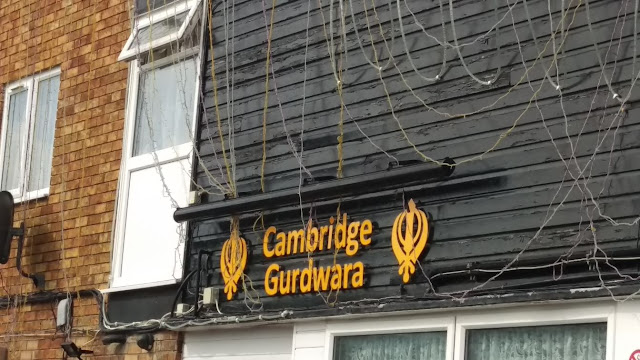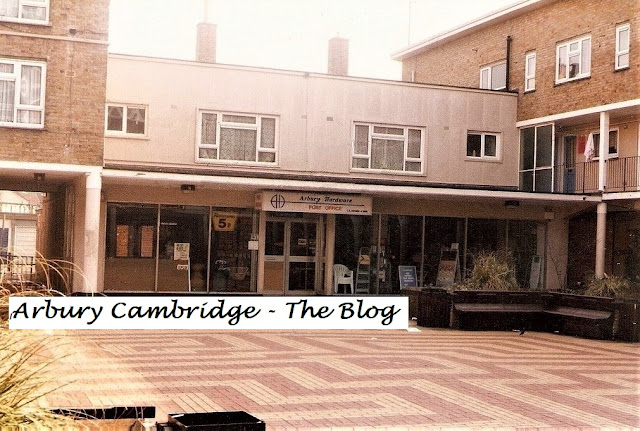A view across Arbury Court, looking towards Arbury Road, in 1976.
A Christmas 1977 'Cambridge Evening News' advertising feature for Arbury Court. Quote: 'Christmas trees and all the other festive trimmings are very much in evidence at Arbury Court, the centre of the massive Arbury housing estate, which has now established its own self-contained community spirit'. By this time, residents had campaigned and raised funds for the Arbury Adventure Playground, on the Nuns Way playing field, the Arbury Community Centre and Arbury Town Park in Campkin Road, and other facilities. 1977 was also the first year of the Arbury Carnival, conceived originally as a one-off event to celebrate the queen's silver jubilee.
The Snowcat in the mid-1960s. It was designed by David Roberts and built by Kidman & Sons, contractors, for the Greene King Brewery at a cost of £16,000 in 1959.
The opening of the Cambridge Gurdwara was a major first for the Sikh community, not only in Arbury, but the whole of Cambridgeshire.
'Cambridge Evening News' advertisement for Palmers Superette, 1970 - the year before decimalisation.
Arbury Court is part of the 'centre' of the original Arbury Estate in Cambridge. The Court, with its pub, supermarket, hardware store and post office, chip shop, newsagent, TV shop, greengrocer, hairdresser, chemist, supermarket and branch library, is part of the 'hub' of the estate.
The historic Arbury district. The Arbury or Harborough (the names were variations on each other and interchangeable, although the Arbury form was more common) Meadows and Furlongs covered land north of Arbury Road, and included a swathe of land south of the road. Arbury Road ran from Milton Road to the Histon/Cambridge Road until the late 1970s. The Manor Farm was formed in the years following the 1840 Chesterton Enclosures. Orchard Park (originally Arbury Park and, before that, Arbury Camp Farm) features the outline of part of the Arbury prehistoric settlement at Ring Fort Road. We've inserted the sites of Arbury Court, Arbury Town Park, the Guided Busway, and the stretch of the Roman road now occupied by Carlton Way.
Arbury Road marks the boundary of North and South Arbury, and also binds the neighbourhood together. As work began on North Arbury and the old Manor Farm/Arbury Meadows and Furlongs became the new estate north of Arbury Road, most of Arbury Court was already built, and beside the Court the Church of the Good Shepherd, the church for the Christian worshippers on the estate, was on the way. The estate's senior school, The Manor, was built in North Arbury, on the northern side of Arbury Road, around the same time as Arbury Court - its opening year was 1959.
The establishment of a GP practice near the school, and the creation of Arbury Town Park and the Arbury Community Centre (1974) in Campkin Road added to the feeling of a 'centre' for the estate, binding North and South Arbury together.
One of the local history displays at Arbury Court, detailing the history of the Arbury district back to prehistoric times.
The Arbury Court public house was called 'The Snowcat' - and it was one of two pubs in South Arbury. The Carlton, in Carlton Way, was the other. North Arbury sprouted The Ship and The Jenny Wren.
The Snowcat changed its name to 'The Grove' - (like the school in Campkin Road - which was named after trees at the Manor Farm) in later years, and is now a Gurdwara (Sikh temple). It was inaugurated in 2013 and was the very first Sikh temple in Cambridgeshire.
Arbury Court Library which was officially opened by the Mayor of Cambridge on 28 January 1966.
When the library was threatened with closure in 1995, Mr R J Tarrant, first librarian-in-charge at Arbury Court, wrote in a letter to the Cambridge Evening News:
I was appointed its first librarian-in-charge when it opened in January 1966, on a three day basis in conjunction with my other charge of Cherry Hinton Library, open on the alternate three days.
Arbury Court was an immediate success. I recall something in excess of 2,000 books being issued on its opening day and within twelve months or so it was operational on a full five-day week and had established itself as the busiest branch library (on book issues) within the city.
Mr Tarrant also wrote that he cherished the memories and friendship of 'Arbury folk' as some of the warmest of his career.
The original supermarket (a small one - a 'superette') at Arbury Court was Palmer's, in the building which later became Arbury Hardware and Post Office. The modern supermarket building arrived later (in the early 1970s).
The Palmers premises were later occupied by Arbury Hardware and Arbury Court Post Office - seen here in the 1980s. There were two other post offices in the area, Arbury Road (at 'Cherry's Corner'), which closed in 1984, and the North Arbury Post Office in Cameron Road.
The Castle School Community Shop in the premises originally occupied by Palmers Superette, 2022.
The new supermarket building was first known as Arbury Discount when it opened on 6 December 1973, and then Bishops from July 1974.
Arbury Discount and Bishops came and went, but Budgens has been a feature of the Arbury Court shopping scene since the early 1980s. In 1993, the store became a discount 'Penny Market' - still owned by the Budgens group, but reverted to the 'Budgens' name in 1995.
One of the main attractions of the Court years ago was Turner's Fish Locker, which served up delicious fish and chips, battered sausages, pies, etc. I well remember, back in the early 1970s, two pictures on the wall in the 'chippie' showing Andy and Florrie Capp of the Daily Mirror comic strip - Andy in one pic. Florrie in the other, waving to each other.
Turners 'Cambridge Evening News' advertisement, 1978.
Turner's fish shop was a wow - providing a special celebratory meal for us once a week - step-dad's pay day!
The Snowcat was my step-dad's 'local' when we lived in Cunningham Close on South Arbury in the early-to-mid 1970s. One of his fellow Snowcat patrons was known as 'Evo-Stik' - as he tended to stick to his cash and hardly ever bought a round!
It all seems such a short time ago.
And yet I'm going back fifty-odd years...
Incredible.
UPDATED 20/11/2025














The area makes more sense with this info so thanks.
ReplyDeleteI suppose Arbury Court is a good example of late 50's architecture. I'm fond of the court but i hope that architecture is never revived.
ReplyDeleteI can remember a dress shop between the Butchers and the Chemist and a wool shop which is now the Key Cutters
ReplyDeleteThe Arbury name completes the history of North Cambridge. Chesterton = Chesterton. Arbury = Before Chesterton, prehistory. King's Hedges? A little farm, not actually in North Arbury/King's Hedges Estate, the name probably derived from a hunting warren composed of hedges. I can never take that last seriously as an area name.
ReplyDeleteAre you sure the library opened as late as 1966? We lived on Arbury Road 1958 - 68 and I could swear I was using the library well before 1966 (previously we had to trek up to Milton Road).
ReplyDeleteMy mother was ambivalent about having 2 bookish daughters and maintained that it was forbidden by the library to borrow our (maximum) 2 books in the morning and change them the same day. This may be true, in the days of the little cardboard slip and manual filing but I've always suspected her of making it up, "You'll ruin your eyes" being a frequent threat.
Amazing! I always had my head in a book and my Mum said: 'One of these days your eyes'll drop out!' Arbury Court Library was one of my favourite local resources. We're as sure as we can be that the official opening was 28 January 1966. Andy has lots more Arbury Court Library material, and we'll post more as time goes on. Thanks again for sharing your memories.
DeleteWe used to get 2 "pennorth" of chips after Brownies in the Church Hut, circa 1963/64. One week, the price had gone up to 3 pence and I was refused, having only 2 pence. I burst into tears and the other customers shamed the owner into letting me off. A belated thank you to those customers!
ReplyDeleteThanks for that. These memories bring times past in the Arbury district to life and we really appreciate them.
DeleteI lived on the Arbury as a child and used to go with my mum to Arbury Court when she went shopping. So much history there. I've heard it's going to be all changed as part of a regeneration project. I live in Cornwall now and am hoping to visit Cambridge next year. I hope it's still the same when I visit.
ReplyDeleteThanks very much indeed for writing. There is still a lot of community spirit in the Arbury district. The Arbury Carnival will be 50 years old in 2027, and the Arbury Community Centre celebrated 50 years in 2024. Hope you enjoy your visit and reliving happy memories. All the best, from the Arbury Archivists
DeleteI also believe the library opened before 1966, but a little while after Arbury Court in 1959. As a child I used to catch the 130 red double decker bus on Alex Wood Road when there was a stop in between the Court and the Library and Alex Wood Road joined Arbury Road in front of the Snowcat. As a child, I used to have my hair cut by a man called Mr. Woods who had a barber shop a couple of doors down from the Snowcat. There was a launderette on the corner next to the Snowcat. There was McCulloch's TV shop run by Mrs. McCulloch and her son, Andrew. I remember a big fire they had there in the early seventies and later a Fire sale of smoke damaged electrical goods before it reopened. McCulloch's moved to a shop on the other side of the Court where the hardware and Post Office started off. The Post Office and hardware shop took over Palmers. I seem to vaguely remember a wool shop, dress shop and ladies hairdresser before a very popular greengrocers to the left of Palmers superette. As you turned the corner there was Farrow's butchers, that later became a cycle shop, the Paper shop, Fish and Chip shop, Markillie's bakery run by Mrs. Sherwood and her daughter Pamela Evans. The Post Office, Curtis's Pork Butchers, a Chemist, the underpass to Alex Wood Road and then finally a Dry Cleaners. Everything people needed could be found on the Court. I was only when the big out of town supermarkets arrived like the Beehive and later Sainsburys and Tesco's that Arbury Court stopped being the only place people ever used.
ReplyDeleteThank you so much! This is wonderfully detailed and just the sort of thing we love. We really appreciate your taking the time to share this information. Andy, our senior Arbury Archivist, recalls Mrs McCulloch, who provided a useful contact for the Arbury Archive back in the early 1980s. The article, like all others on here, is periodically updated with new information as Andy goes through the files of local newspapers that he made at the Cambridgeshire Collection years ago, and we have now included an account of the early days at Arbury Court Library, written by its original librarian-in-charge Mr Tarrant, which repeat the 1966 opening claim (three days a week initially) but we are open to any further information on the subject. Thank you again!
Delete